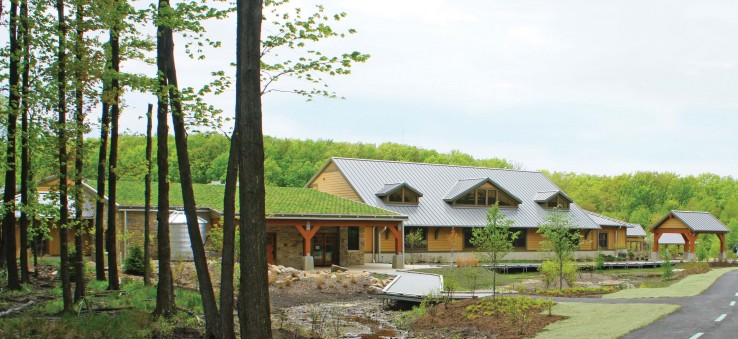On February 25, the NEOSCC Board voted unanimously to approve and endorse the Vibrant NEO 2040 Vision, Framework and Action Products. We are sharing an “Initiative A Day” so you can gain a better understanding of the vision and framework! If you would like to read all of the Initiatives, you can download them here: Recommendation and Initiatives. You can access a pdf of the entire vision chapter here. The vision chapter contains all 41 initiatives, development strategies, indicators, and matrices that identify how the recommendations, initiatives and indicators all relate.
Show your support for Vibrant NEO 2040 by adding your name to our Champions of Vibrant NEO 2040 list here.

INITIATIVE 7.3: IMPROVE REGIONAL QUALITY OF LIFE AND HEALTH BY FOCUSING ON THE INTERFACE BETWEEN NATURAL AND HUMAN SYSTEMS IN THE AREAS OF FLOOD MITIGATION, STORMWATER RUN-OFF, AND CLEAN BEACHES AND THE WATER QUALITY OF OUR LAKES, RIVERS, AND STREAMS.
WHAT THIS MEANS. The quality and cleanliness of the region’s water resources are shaped by interactions between human and natural systems. At the center of this dynamic are engineered and natural forms of hydrography. Engineered hydrography consists of sewers, culverts, ditches, levies, dams, and the “softer” treatments advocated in 7.2; natural hydrography consists of creeks, streams, rivers, lakes, ponds and reservoirs—any natural path taken by water. As watersheds urbanize, engineered hydrography replaces natural systems, putting increased stress on remaining natural hydrographic features. The effects of such stress can be observed in bank erosion, deep channelization, and increased pollutant loads in streams and rivers, which have downstream consequences for larger aquatic systems such as Lake Erie.
In recent years, engineers, landscape architects, and planners have realized the extent of damage wrought by previous generations of practice and explored new stormwater management strategies at a variety of scales. Strategies are policy-based, such as enacting stricter floodplain regulations, as well as project-based, such as installation of bioswales and rain gardens.
WHY THIS IS IMPORTANT. Engineered systems do not so much “control” natural systems as redirect their energy, to either positive or negative effect. The harmful effects of previous generations of engineered hydrography on natural systems have already been covered, but with an increasingly volatile climate, their core intended function of “protecting” communities will be pushed to and beyond the point of failure. New infrastructural strategies for managing and cleansing stormwater, as well as understandings of failure risk, are needed to better protect lives and property in a climate-uncertain future. These strategies should be based on designing infrastructure that more closely mimic natural hydrographic function, and using policy to define a safe relational distance for development.
GETTING IT DONE. This is a multi-faceted initiative, involving action at numerous scales: regional, watershed, and site. NEOSCC and its consortium partners should take lead by engaging the region’s soil and water conservation districts, sanitary districts, the Cuyahoga Valley National Park and the region’s Metroparks to survey existing practice and develop a suite of water management strategies and tools applicable to the region’s watersheds. Several entities in Northeast Ohio already have a strong start on this; by facilitating networking and knowledge exchange, best practices can be scaled regionally.
BEST PRACTICE: Stark County Storm Water Management Program: A consortium established by the Stark County Regional Planning Commission was created to map storm water features in the urbanized area in Stark County, Ohio. This concept was mandated by the Ohio EPA and falls under the NPDES Phase II regulations.
TOOL: Stark County Water Quality Protection Toolkit: The Nimishillen Creek Watershed lies almost entirely in Stark County. The Stark County Planning Commission used this watershed as a model and organized data to create a water quality protection toolkit. The toolkit is divided into five sections. The first four sections address current sources of pollution: storm water runoff and flooding, agricultural runoff, failing home sewage treatment systems and acid mine drainage. The last section addresses how to prevent future sources of pollution. In each section, possible solutions are suggested along with information regarding funding sources and implementation for each solution.
PILOT PROJECT: Lakewood Lakefront Open Space Project: The project consists of the acquisition of approximately one acre of beach area on Lake Erie. In addition to public access the project provides for the introduction of appropriate native plantings; creates habitat; prevents erosion; and completes an aesthetically pleasing resource.
| Lead | Metroparks Authorities, Land Conservancies and Trusts; Municipalities, Townships, Counties; Councils of Governments |
| Target Community | Strategic investment areas, asset risk areas, cost risk areas |
| Implementation Complexity | Moderate |
These recommendations, initiatives, and products, are not one-size-fits all and some aspects of the initiatives won’t be applicable everywhere in the 12-county region. The Vibrant NEO 2040 Vision, Framework and Products are intended inspire and guide decision-making at the Metropolitan Planning Organization (MPO), Council of Government, and local levels to ensure that land use, transportation, and environmental considerations are simultaneously addressed by their processes. Ultimately, the implementation of Vibrant NEO 2040 is up to Northeast Ohio’s communities and residents. But regardless of the applicability of each initiative to any particular part of the region, the goal for each community within the Vision is the same: stability, prosperity, and a high quality of life for all of its residents.
